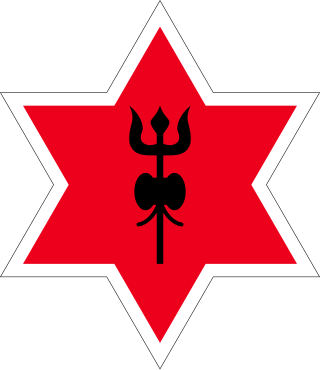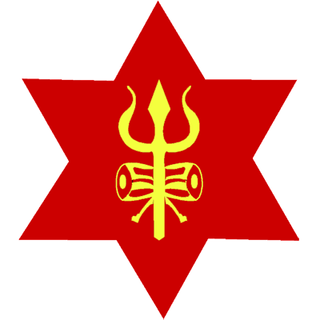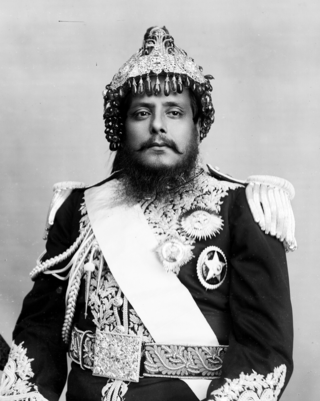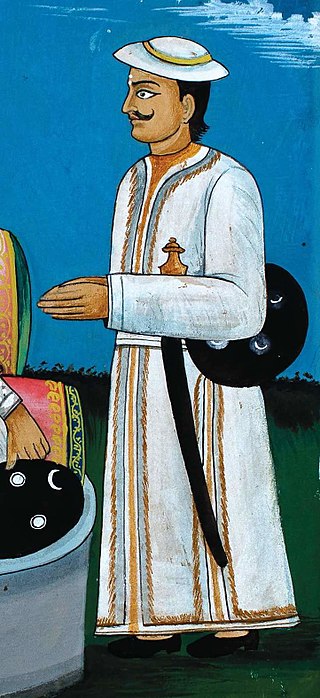Related Research Articles

The Nepali Armed Forces are the military forces of Nepal. Composed primarily of the ground-based Nepali Army, organized into six active combat divisions, the Nepalese Armed Forces also operates the smaller Nepalese Army Air Service designed to support army operations and provide close light combat support. The Nepalese Army also operates smaller formations responsible for the organization of air defense, logistics, military communications, artillery, and airborne forces within Nepalese territory. In addition, the Armed Police Force acts as a paramilitary force tasked with maintaining internal security within Nepal.

Chhetri, historically called Kshettriya or Kshetriya or Khas are Nepali speaking Rajputs historically associated with the warrior class and administration, some of whom trace their origin to migration from medieval India. Chhetri was a caste of administrators, governors, warriors and military elites in the medieval Khas Kingdom and Gorkha Kingdom. The nobility of the Gorkha Kingdom mainly originated from Chhetri families. They also had a strong presence in civil administration affairs. The bulk of prime ministers of Nepal before the democratization of Nepal belonged to this caste as a result of the old Gorkhali aristocracy. Gorkha-based aristocratic Chhetri families included the Pande dynasty, the Basnyat dynasty, the Kunwar family and the Thapa dynasty.

The Nepali Army, also referred to as the Gorkhali Army, is the land service branch of the Nepali Armed Forces. After the Gorkha Kingdom was founded in 1559, its army was established in 1560, and initially became known as the Gorkhali Army. Later it was known as the Royal Nepali Army (RNA) following the Unification of Nepal, when the Gorkha Kingdom expanded its territory to include the whole country, by conquering and annexing the other states in the region, resulting in the establishment of a single united Hindu monarchy over all of Nepal. It was officially renamed simply to the Nepali Army on 28 May 2008, upon the abolition of the 240-year-old Nepalese monarchy, and of the 449-year-old rule of the Shah dynasty, shortly after the Nepalese Civil War.

Commanding General Shree Maharaja Sir Bir Shumsher Jung Bahadur Rana was the 11th Prime Minister of Nepal. He is remembered as a statesman who made reforms and infrastructure improvements. Bir Shamsher Jung Bahadur Rana was known as Kailay in his childhood; this name was given by Jung Bahadur. His mother was daughter of Pahalman Singh Basnyat and sister of Lalitman Singh Basnyat. His mother died at his birth and he was taken care of by Putali Maharani, wife of Jung Bahadur. He spent his childhood at Thapathali Durbar.

Kaji was a title and position used by nobility of Gorkha Kingdom (1559–1768) and Kingdom of Nepal between 1768 and 1846. Many other contemporary kingdoms used the same title for their ministers.

Abhiman Singh Basnet/Basnyat was the first Commander-in-Chief of unified Nepal. Abhiman Singh became the first Commander in Chief after General Kalu Pande died during his second attempt to capture Kirtipur.
Princess Jyotshana Rajya Lakshmi Devi Shah of Nepal is a member of the former Nepalese royal family. Jyotshana and her husband, diplomat Singha Bahadur Basnyat, have worked to internationally promote Nepalese culture.
Mahat (Nepali: महत) is an Ekthariya chhetri surname among Nepalese, of Khasa heritage. The name may have originated when one of the Jumli Malla kings in medieval times made his younger brother, Dharma Malla, chief of staff in the army. This granted Dharma Malla the title of Mahat (Kshatriya) (meaning The Great One), and as a result, his descendants started using 'Mahat' as their surnames.

Shivaram Singh Basnyat was the military commander of Gorkha. After the conquest of Naldum area by the Gorkhalis, he along with Commander Bir Bhadra Thapa conquered Sanga, Panauti, Sankhu and adjacent areas. They received fierce resistance from the Kantipur Kingdom at Sangachok. He died in the defensive battle of Sanga Chowk during Unification of Nepal on 1803 B.S.

Vamsharaj Pande was a Nepalese politician, military officer and minister of state. He was a significant army commander of Kingdom of Nepal in the second half of the 18th century. He was a follower of Bahadur Shah of Nepal and had a significant rivalry with Swaroop Singh Karki.
Bir Bhadra Thapa or Birabhadra Thapa also spelled Virabhadra or Virbhadra, was a politician, courtier and military officer in the Gorkha Kingdom during the 18th century. Born in the medieval Tanahun Kingdom, he left his ancestral property there and migrated to the uprising Gorkha Kingdom. He got entry into the minor ranks of military of King Prithvi Narayan Shah due to being a nephew of Sura Prabha, the wife of military commander Shivaram Singh Basnyat of the Basnyat dynasty. Thereafter, he took part in the various battles of Unification of Nepal throughout his life. Among his grandsons, Bhimsen Thapa went on to become the Mukhtiyar of Nepal for 31 years and founder of Thapa dynasty.
Padma Bahadur Khatri was a foreign minister of Nepal, and also served as an army officer and diplomat.

Mulkaji was the position of head of executive of Kingdom of Nepal in the late 18th and early 19th centuries. It was equivalent to Prime Minister of Nepal. There were 5 Mulkajis appointed between 1785 and 1804.
Swarup Singh Karki or Swaroop Singh Karki, was a Nepali politician, courtier, military commander and minister. He was popular for his singing prowess and court conspiracies. He was selected as Dewan in the reign of King Pratap Singh Shah and a significant politician in the regent rule of Queen Rajendra of Nepal. He was one of the most influential court politician in the rule of King Pratap Singh and Queen Rajendralaxmi, others being his rival Bahadur Shah of Nepal and Vamsharaj Pande. Vamsharaj was his perceived career rival. His life and career ended when Prince Bahadur Shah was appointed as regent in 1785.
Kaji Sarbajit Rana Magar or simply Sarbajit Rana was a Nepalese politician, minister and courtier in the Kingdom of Nepal. He became a prominent minister during the regency of Queen Rajendra Laxmi and was a significant personality in central politics in the Kingdom of Nepal. He was assassinated by opponents of Rajendra Laxmi on the charges of having illicit relationship with the Queen.
The Chief of the Nepalese Army is the military position of army head of the Nepalese Army, initially known as Gorkhali Army. The Chief of the Nepalese Army had been from among the Kaji officers during the 18th century. During the reign of Bhimsen Thapa, the title of Commander-in-Chief was introduced for the first time for denoting the army chief. Later in the late 1970s, the title was changed to Chief of Army Staff (CoAS). Currently, the Chief of Army Staff is the Chief of the Nepalese Army.Gurung Magar Thakuri were thakurai/chatrapal/thakurs /kings of western Nepal.Some of chief army head of Nepal is missing.

The Chief of the Army Staff (COAS), informally known as Chief Sa'ab, is the chief commander of the Nepalese Army.
Rajguru Gajraj Mishra also spelled Gajaraj Mishra was a Nepalese politician, ambassador, diplomat and a royal priest of Shah dynasty. He was always inclined to his disciple Prince Regent Bahadur Shah of Nepal. Gajraj Mishra was disfavoured by his disciple King Pratap Singh Shah due to his support to Prince Bahadur Shah. He was also disfavoured by Pratap Singh's son Rana Bahadur Shah.
Jharra Chhetri are the subgroup of the Chhetri/Kshatriya caste. Jharra Chhetri wear the six threaded Janai. They are historically Indo Aryan people. Communities of Jharras are Basnet/Basnyat, Thapa, Karki, Kunwar, Khadka, Katuwal,Rawat,Bisht etc.
References
- ↑ Karki 1983.
- 1 2 Khatri 1999, p. 121.
- ↑ Not to be confused with Nepalese Ambassador to Britain, late Dr. Singha Bahadur Basnyat, husband of Princess Jyotshana Basnyat of Nepal
- ↑ Khatri 1999, p. 120.
- ↑ United States Foreign Broadcast Information Services 1974.